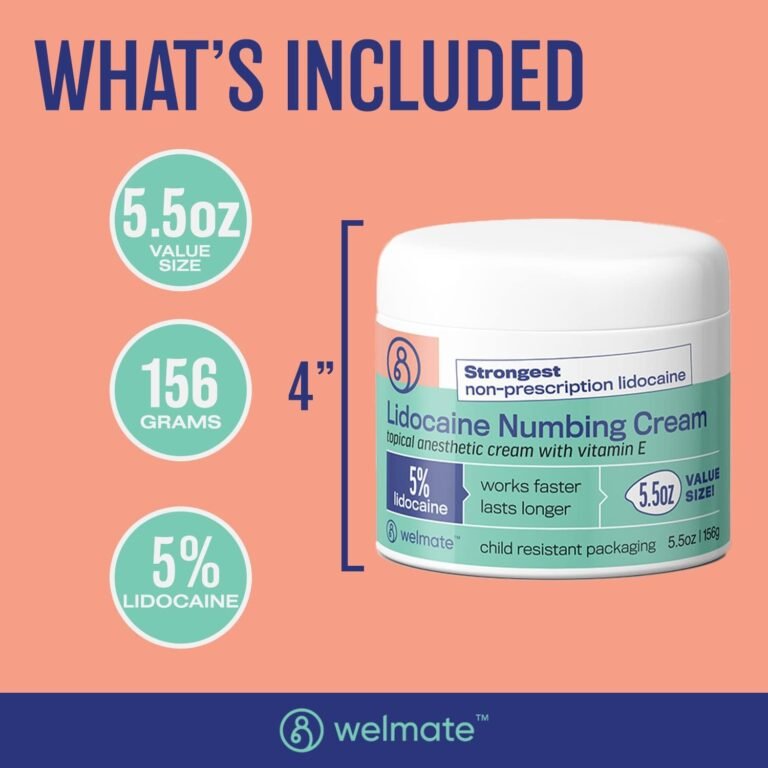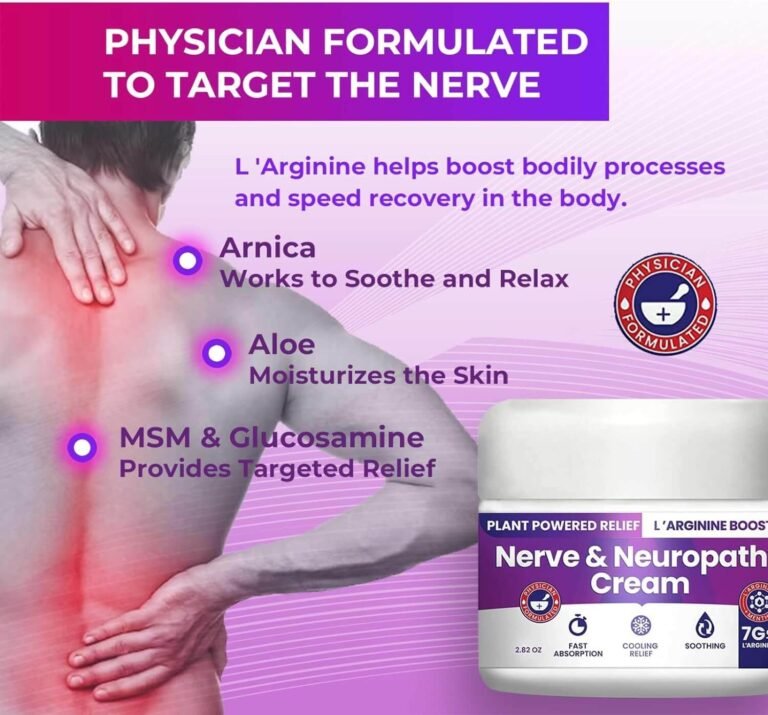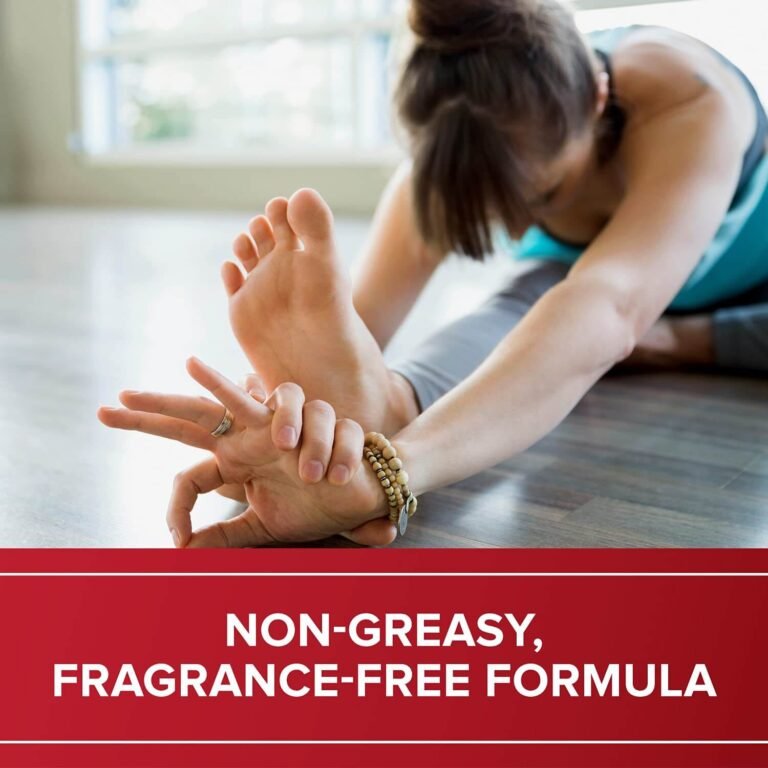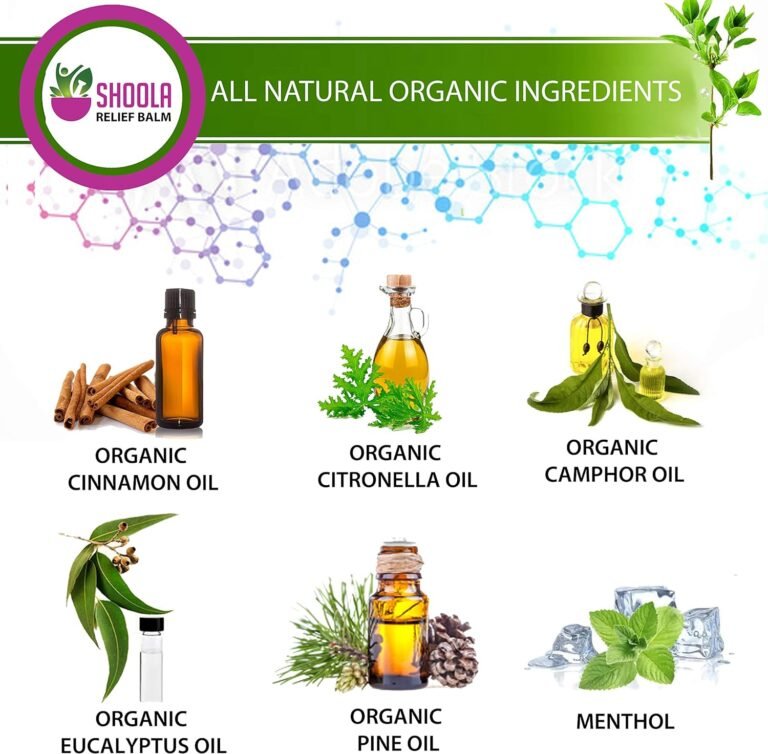Soothe Sore Muscles with Medicated Rubs
Medicated rubs are a popular choice for soothing sore muscles and joints, providing effective pain relief and promoting muscle recovery. These topical pain relief products come in various forms, including muscle balms, gels, and creams. They contain different ingredients, such as counterirritants like menthol and camphor, salicylates like methyl salicylate, prescription NSAIDs, capsaicin derived from chili peppers, and lidocaine for numbing pain.
When using medicated rubs, it is important to read the directions carefully, as they provide specific instructions for application. Avoid applying the rubs to broken or irritated skin, and do not use them with a heating pad or under a tight bandage. Following these guidelines will ensure safe and optimal usage.
Hot and cold packs can also provide relief for sore muscles and joints. Cold packs help reduce inflammation, while heat packs promote muscle relaxation. It is recommended to use heat or cold for 15-20 minutes at a time and test the temperature before applying to avoid burns or further discomfort.
Key Takeaways:
- Muscle rubs are effective in soothing sore muscles and joints.
- They come in various forms, such as balms, gels, and creams.
- Common ingredients include menthol, camphor, salicylates, capsaicin, and lidocaine.
- Follow the directions on the packaging for safe and optimal usage.
- Hot and cold packs can provide additional relief for muscle and joint pain.
Understanding Muscle Rub Ingredients
Muscle rubs contain a variety of ingredients that work together to relieve muscle pain and discomfort. These topical pain relief products come in different forms such as creams, gels, and balms, but they all share a common goal – to provide soothing relief for sore muscles and joints. Understanding the ingredients in muscle rubs can help you choose the right product for your needs.
Counterirritants: Menthol and Camphor
One of the key ingredients found in muscle rubs is counterirritants, such as menthol and camphor. These substances work by creating a cooling sensation on the skin, which distracts from pain and provides a soothing effect. Menthol is derived from peppermint oil and has a refreshing, minty smell. Camphor, on the other hand, is made from the wood of the camphor tree and has a slightly medicinal aroma.
Counterirritants like menthol and camphor are believed to work by stimulating nerve endings on the skin, which can help to reduce pain signals. They also produce a sensation of warmth or cooling, which can provide temporary relief from muscle aches and discomfort. Although the exact mechanisms are not fully understood, many people find these ingredients to be effective in alleviating muscle pain.
Salicylates and Methyl Salicylate
Salicylates are another common ingredient found in muscle rubs. These compounds, including methyl salicylate, are derived from salicylic acid, which is naturally found in plants such as wintergreen and birch. Salicylates work by reducing inflammation and inhibiting the production of certain enzymes that contribute to pain and swelling.
Methyl salicylate, in particular, has a warming sensation when applied to the skin. It penetrates deep into the muscles and joints, providing targeted relief for localized pain. Salicylate-based muscle rubs are often recommended for conditions such as arthritis, tendonitis, and muscle strains.
Prescription NSAIDs
In some cases, muscle rubs may also contain prescription nonsteroidal anti-inflammatory drugs (NSAIDs), such as diclofenac. These medications work by reducing inflammation and inhibiting the production of prostaglandins, which are substances that contribute to pain and swelling. Prescription NSAIDs can provide stronger pain relief and are typically used for more severe muscle and joint pain.
It is important to note that muscle rubs containing prescription NSAIDs should only be used under the guidance of a healthcare professional, as they may interact with other medications or have potential side effects. Always read the product labeling and consult with a healthcare provider before using these types of muscle rubs.
| Ingredients | Common Effects |
|---|---|
| Counterirritants (Menthol, Camphor) | Cooling sensation, distraction from pain |
| Salicylates (Methyl Salicylate) | Reduces inflammation, inhibits pain-producing enzymes |
| Prescription NSAIDs (Diclofenac) | Stronger pain relief, reduces inflammation |
| Capsaicin | Blocks pain signals, long-lasting relief |
| Lidocaine | Numbing effect, temporary pain relief |
When using muscle rubs, it is important to follow the directions provided on the packaging. This includes applying the product to clean, intact skin and avoiding sensitive areas. It is also recommended to avoid using muscle rubs with a heating pad or under a tight bandage, as this can increase the risk of skin irritation or burns.
While muscle rubs can provide effective relief for sore muscles and joints, it is worth noting that there are alternative methods available. Hot and cold packs, for example, can also help reduce muscle pain and inflammation. Applying a cold pack to the affected area can help numb the pain and reduce swelling, while using a hot pack can promote muscle relaxation and improve blood flow.
When using hot and cold packs, it is important to use them safely and correctly. It is recommended to apply heat or cold for 15-20 minutes at a time, with a break in between to allow the skin to return to its normal temperature. Always test the temperature of the pack before applying it to the skin to avoid burns or further discomfort.
Capsaicin and Lidocaine for Targeted Relief
Muscle rubs often incorporate capsaicin and lidocaine to offer targeted relief for specific areas of pain. Capsaicin, derived from chili peppers, works by blocking pain signals, while lidocaine acts as a numbing agent. These ingredients provide a dual-action approach to pain relief, addressing both the perception and sensation of pain.
Capsaicin, when applied topically, binds to receptors in the skin, triggering a warming sensation that distracts from the underlying pain. Additionally, it can help decrease the levels of Substance P, a neurotransmitter that plays a role in transmitting pain signals to the brain. This makes capsaicin an effective ingredient for managing chronic muscle and joint pain.
Lidocaine, on the other hand, works by blocking the transmission of nerve signals in the area where it is applied. It numbs the skin, reducing the sensation of pain and providing temporary relief. Lidocaine is commonly used in muscle rubs due to its fast-acting nature and ability to target localized pain. It is especially effective in alleviating discomfort caused by muscle strains, sprains, and minor injuries.
When applied together, capsaicin and lidocaine create a synergistic effect, maximizing pain relief and providing targeted comfort. This combination can be found in various muscle rub products, offering consumers a powerful solution for managing muscle and joint pain.
Proper Usage and Precautions
When using muscle rubs, it is crucial to adhere to the provided directions to ensure safety and optimal results. Here are some important guidelines to follow:
- Read the directions carefully: Each muscle rub product may have specific instructions regarding application, frequency, and duration. It is essential to read and understand these instructions before using the product.
- Avoid applying to broken or irritated skin: Muscle rubs are designed to be applied topically, but they should not be used on open wounds, cuts, or broken skin. Applying the product to broken skin can cause irritation or further damage.
- Do not use with a heating pad: While muscle rubs provide heat-like sensations, using them with a heating pad can increase the risk of burns or skin irritation. It is best to avoid using a heating pad while using muscle rubs.
- Avoid using under a tight bandage: Applying a muscle rub under a tight bandage can increase the absorption of the product, leading to potential adverse effects or excessive medication exposure. It is recommended to use muscle rubs on clean, dry skin without any tight bandages.
Following these guidelines will help ensure the safe and effective use of muscle rubs for soothing sore muscles and joints. Remember to consult with a healthcare professional if you have any concerns or specific medical conditions.
| Do: | Don’t: |
|---|---|
| Apply the muscle rub according to the provided directions | Apply to broken or irritated skin |
| Use the product on clean, dry skin | Use the muscle rub with a heating pad |
| Test the temperature before applying heat or cold packs | Apply the muscle rub under a tight bandage |
Proper usage and precautions are essential when using muscle rubs. By following the provided directions and avoiding common mistakes, you can maximize the benefits of these products and minimize any potential risks.
Alternatives to Muscle Rubs
In addition to muscle rubs, there are alternative options available for relieving sore muscles and joints. One popular method is the use of hot and cold packs, which can provide targeted relief and promote muscle recovery. Cold packs are effective in reducing inflammation, while hot packs help relax muscles and improve blood flow. Here’s a breakdown of how these alternative options work:
Cold Packs
Cold packs, also known as ice packs or gel packs, are commonly used to reduce inflammation in sore muscles and joints. Applying a cold pack to the affected area can help numb the area and decrease swelling. To use a cold pack, simply place it on the affected area for 15-20 minutes at a time. Remember to wrap the cold pack in a towel or cloth to protect your skin from direct contact with the cold temperature.
Hot Packs
Hot packs, such as heating pads or warm towels, are beneficial for relaxing tight muscles and increasing blood flow to the affected area. The heat helps soothe muscle tension and promotes healing. To use a hot pack, apply it to the affected area for 15-20 minutes at a time. Be cautious of the temperature to avoid burns; always test the heat before placing it on your skin.
It’s important to note that hot and cold packs are not meant to be used at the same time. Instead, alternate between hot and cold therapy based on your specific needs. If you’re unsure which option to use, consult with a healthcare professional for personalized advice.
| Benefits of Hot Packs | Benefits of Cold Packs |
|---|---|
| – Relaxes tight muscles | – Reduces inflammation |
| – Increases blood flow | – Numbs the area |
| – Soothes muscle tension | – Decreases swelling |
By incorporating hot and cold therapy into your muscle recovery routine, you can find relief from sore muscles and joints. Remember to use these alternative options safely and follow the recommended guidelines for duration and temperature. Whether you choose muscle rubs or alternative methods, finding the right approach for your needs can help you maintain comfort and mobility in your everyday activities.
How to Use Hot and Cold Packs
To effectively use hot and cold packs for muscle pain relief, it is important to follow proper guidelines. Cold packs can help reduce inflammation, while hot packs promote muscle relaxation. By alternating between the two, you can experience relief from sore muscles and joints.
When using a cold pack, it is recommended to apply it to the affected area for 15-20 minutes at a time. This can help reduce swelling and numb the area, providing temporary relief from pain. To avoid direct contact with the skin, wrap the cold pack in a cloth or towel before applying.
Heat packs can also be beneficial for soothing muscle pain. Similar to cold packs, it is recommended to apply heat for 15-20 minutes at a time. You can use a hot water bottle, heating pad, or warm towel to apply heat to the affected area. However, it is important to test the temperature of the heat pack before applying to avoid burns or discomfort.
Table: Guidelines for Hot and Cold Pack Usage
| Hot Pack | Cold Pack |
|---|---|
| Apply heat for 15-20 minutes | Apply cold for 15-20 minutes |
| Test temperature before applying | Wrap cold pack in cloth or towel |
| Avoid using with a heating pad | Do not apply to broken or irritated skin |
It is worth noting that hot and cold packs should not be used as a substitute for seeking medical advice. If you are experiencing severe or persistent muscle pain, it is recommended to consult a healthcare professional. They can provide a proper diagnosis and recommend appropriate treatment options.
Top-Rated Muscle Rubs on the Market
There are several top-rated muscle rubs on the market that have received positive feedback for their ability to soothe sore muscles. These products have gained popularity among athletes, fitness enthusiasts, and individuals seeking relief from muscle aches and pains.
One of the highly regarded muscle rubs is Icy Hot, which offers a range of products, including balms, gels, and creams. Icy Hot provides a cooling sensation that helps distract from the pain, thanks to its menthol and camphor content. Its effectiveness in soothing sore muscles has made it a go-to choice for many.
| Brand | Product Type | Key Ingredients |
|---|---|---|
| Icy Hot | Balm, Gel, Cream | Menthol, Camphor |
| Biofreeze | Gel | Menthol |
| Salonpas | Patch | Methyl Salicylate |
Biofreeze is another popular brand known for its ability to provide effective relief. Its gel formula with menthol offers a cooling effect that can help alleviate muscle discomfort. Many users have praised Biofreeze for its fast-acting properties and long-lasting relief.
If you prefer a patch format, Salonpas is a trusted choice. These patches contain methyl salicylate, which acts as a pain reliever. They offer targeted relief and are convenient to use, making them a preferred option for many individuals.
When it comes to finding the right muscle rub for your needs, it’s important to consider factors such as the product type, ingredients, and your individual preferences. Each person may respond differently to different brands and formulations, so it may be worthwhile to try out a few options to find the one that works best for you.
The Benefits of Medicated Muscle Rubs
Medicated muscle rubs offer numerous benefits, making them a popular choice for individuals seeking relief from muscle aches and pains. These topical pain relief products are specially formulated to provide targeted relief and promote muscle recovery. By applying a medicated rub directly to the affected area, users can experience soothing sensations and reduced discomfort.
One of the key benefits of using muscle rubs is their ability to alleviate soreness and tension in the muscles. Whether it’s from an intense workout, sports-related injury, or general muscle fatigue, applying a medicated rub can help ease the ache and promote faster recovery. These products typically contain ingredients like counterirritants, such as menthol and camphor, which provide a cooling effect to distract from pain.
Another advantage of medicated muscle rubs is their convenience and ease of use. Unlike other forms of pain relief, such as oral medications or injections, muscle rubs can be applied directly to the affected area without the need for additional equipment or medical intervention. This makes them a practical option for on-the-go relief or for individuals who prefer a non-invasive approach to managing muscle aches.
Additionally, medicated muscle rubs can improve overall comfort and quality of life. By relieving muscle aches and pains, individuals can experience increased mobility and flexibility, allowing them to engage in their daily activities with ease. Whether it’s a simple task like lifting groceries or participating in physical activities like exercise or sports, the use of muscle rubs can enhance overall well-being and promote a more active lifestyle.
Popular Brands for Muscle Rubs
Several popular brands have gained recognition for their muscle rub products, offering trusted options for individuals seeking relief. These brands have established themselves as leaders in the industry, delivering effective solutions for soothing sore muscles and joints. Among the top-rated brands are Icy Hot, Biofreeze, and Salonpas.
Icy Hot is known for its dual-action formula that provides both a cooling and warming sensation. The menthol and camphor in Icy Hot work as counterirritants, helping to distract from pain and discomfort. With a range of products including patches, creams, and gels, Icy Hot offers versatile options for targeted relief. Their products are widely available and have garnered positive reviews from satisfied customers.
Biofreeze is another well-regarded brand that specializes in topical pain relief. Their products contain menthol, which provides a cooling sensation to alleviate muscle soreness. Biofreeze offers a variety of application formats, including roll-ons, sprays, and tubes, allowing users to choose the most convenient option for their needs. The brand’s commitment to quality and effectiveness has made them a popular choice among individuals looking for fast and reliable relief.
Salonpas is a trusted brand that has been providing pain relief solutions for over 80 years. Their products feature a combination of active ingredients, including menthol, methyl salicylate, and camphor, to deliver targeted relief to muscles and joints. Salonpas offers a wide range of products, including patches, creams, and gels, ensuring that users can find the right option for their specific needs. With a strong reputation and a long history of success, Salonpas continues to be a go-to brand for many individuals seeking relief from muscle aches and pains.
Comparison Table: Popular Muscle Rub Brands
| Brand | Active Ingredients | Application Formats | Customer Reviews |
|---|---|---|---|
| Icy Hot | Menthol, Camphor | Patches, Creams, Gels | Positive |
| Biofreeze | Menthol | Roll-ons, Sprays, Tubes | Positive |
| Salonpas | Menthol, Methyl Salicylate, Camphor | Patches, Creams, Gels | Positive |
When choosing a muscle rub, it’s important to consider your specific needs and preferences. These popular brands offer a range of options to suit different preferences and deliver effective relief. Whether you’re looking for a cooling sensation, a warming effect, or a combination of both, these trusted brands have you covered. Always read the directions carefully and consult with a healthcare professional if you have any concerns or questions about using these products.
Patches and Other Innovative Options
In addition to traditional muscle rubs, there are innovative options available, such as patches that provide pain relief through the skin. These patches contain ingredients like lidocaine and diclofenac, which are known for their analgesic properties. They are designed to adhere to the affected area, allowing the active ingredients to penetrate the skin and target the source of pain directly.
The advantage of patches is their convenience and ease of use. They can be applied discreetly and worn throughout the day, providing continuous relief without the need for frequent reapplication. Some patches come in different sizes to accommodate various body parts, ensuring a comfortable fit and effective coverage.
One popular type of patch is the lidocaine patch, which contains a numbing agent that helps to alleviate pain and discomfort. These patches are particularly useful for localized pain, such as muscle strains or joint inflammation. Another innovative option is the diclofenac patch, which delivers a nonsteroidal anti-inflammatory drug (NSAID) directly to the affected area to reduce inflammation and provide pain relief.
| Patch Type | Active Ingredient | Advantages |
|---|---|---|
| Lidocaine Patch | Lidocaine | – Numbs pain – Convenient and discreet – Targeted relief |
| Diclofenac Patch | Diclofenac (NSAID) | – Reduces inflammation – Long-lasting relief – Easy to apply |
When using patches, it is important to follow the instructions provided by the manufacturer. Clean and dry the affected area before applying the patch, ensuring that the skin is free from lotions or oils that may impede absorption. Some patches can be worn for a specified period of time, while others may need to be replaced after a certain number of hours. It is advisable to consult a healthcare professional to determine the most suitable patch and usage guidelines for your specific condition.
Conclusion
Muscle rubs and other pain relief options provide effective solutions for soothing sore muscles and promoting overall comfort and well-being. These topical pain relief products, available in forms such as balms, gels, and creams, contain a variety of ingredients that work to alleviate muscle aches and pains. Counterirritants like menthol and camphor provide a cooling sensation that distracts from pain, while salicylates like methyl salicylate act as pain relievers. Some muscle rubs even include prescription NSAIDs for stronger pain relief.
Capsaicin, derived from chili peppers, and lidocaine, a numbing agent, offer targeted relief when included in muscle rubs. It’s important to follow the directions carefully when using these products, avoiding application to broken or irritated skin and refraining from using them with a heating pad or under a tight bandage.
If you prefer alternative methods for pain relief, hot and cold packs can be effective options. Cold packs help reduce inflammation, while hot packs promote muscle relaxation. It’s recommended to use heat or cold for 15-20 minutes at a time and test the temperature before applying to avoid burns or discomfort.
When it comes to muscle rubs, there are several top-rated brands to choose from, including Icy Hot, Biofreeze, and Salonpas. These brands are known for their effectiveness in providing relief from muscle aches and pains.
For those seeking innovative options, patches have emerged as convenient alternatives. These patches deliver medication through the skin and can contain ingredients like lidocaine and diclofenac for pain relief. They offer a practical and efficient way to manage muscle discomfort.
Overall, muscle rubs and other pain relief options offer targeted relief, promote muscle recovery, and improve overall comfort. By following the usage instructions and considering alternative methods, individuals can find the right solution for their specific needs, ensuring relief from muscle soreness and discomfort.
FAQ
What are the common ingredients in muscle rubs?
Muscle rubs may contain counterirritants like menthol and camphor, salicylates like methyl salicylate, prescription NSAIDs, capsaicin derived from chili peppers, and lidocaine for numbing pain.
How should I use muscle rubs?
It is important to read the directions carefully and follow them. Avoid applying muscle rubs to broken or irritated skin, and do not use them with a heating pad or under a tight bandage.
Can I use hot and cold packs for muscle pain relief?
Yes, hot and cold packs can provide relief for sore muscles and joints. Cold reduces inflammation, while heat relaxes muscles. Use heat or cold for 15-20 minutes at a time and test the temperature before applying.
Are there any precautions I should take when using muscle rubs?
Yes, it is important to avoid applying muscle rubs to broken or irritated skin. Furthermore, do not use muscle rubs with a heating pad or under a tight bandage.
What are some popular brands of muscle rubs?
Some popular brands of muscle rubs include Icy Hot, Biofreeze, and Salonpas.
Are there alternatives to using muscle rubs for pain relief?
Yes, hot and cold packs can be used as alternatives to muscle rubs. Cold reduces inflammation, while heat promotes muscle relaxation.







